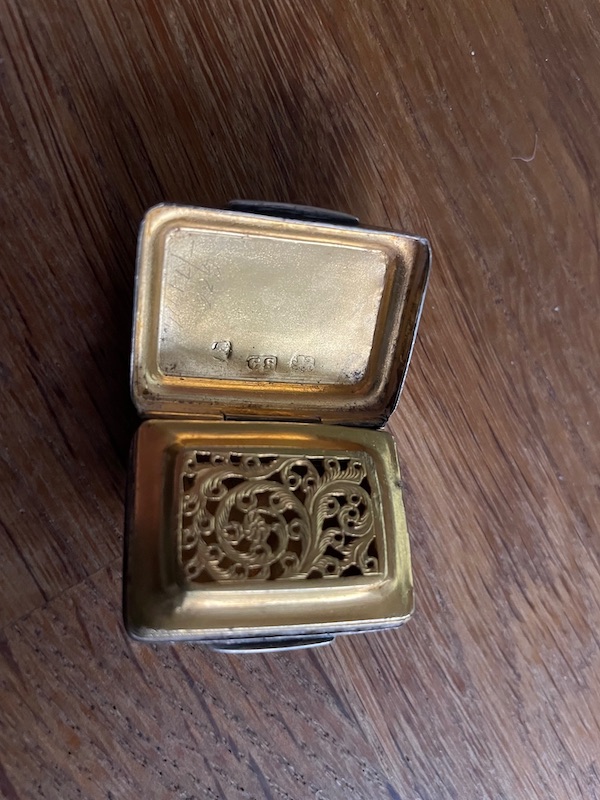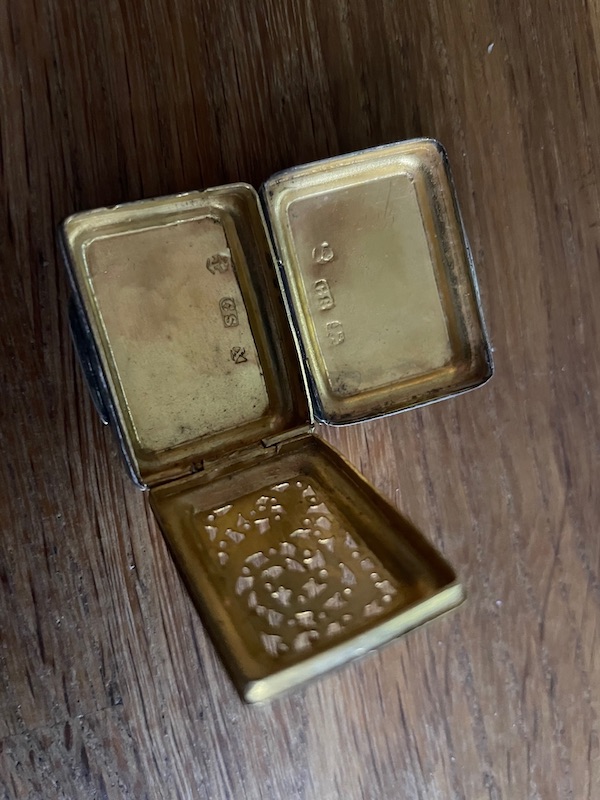
On my recent trip to Bath I spotted something that set my pulse racing. No not George Clooney, but a delightfully tiny silver box.
I recognised what it was immediately – a silver vinaigrette box. Now, if you read Regency novels you will probably know what these items were used for. In days gone by, when personal hygiene and sanitation wasn’t as efficient as it is today, malodourous smells were the norm. To combat this, many people carried around one of these. Containing a small sponge soaked in vinegar and sweet smelling herbs and spices or perfume beneath a perforated grille, a quick sniff would help a lady to deal with the stench.

These items had their historical roots much further back in time to at least the 14th century and were based on the same principal as pomanders. Pomanders were ornamental apple-shaped containers holding ambergris, a waxy resin to which perfume was added. Usually worn round the waist, these items were often indicators of wealth with their intricate and opulent designs and decorations. Pomanders were particularly popular when plague was about, as it was thought that disease was spread through foul air. Smelling perfume instead was considered one way of avoiding illness.

By the late eighteenth century, pomanders were being replaced by smaller objects like the silver vinaigrette. Small and discreet, they were popular with Regency ladies who could keep them in their reticules and they could be as elaborate or a simple as the owner’s purse allowed. As well as being useful for dealing with bad odours, vinaigrette boxes were also a good alternative for carrying one’s favourite perfume when travelling.

Generally, they were made of silver with a gilt interior. The gilt prevented the vinegar in the sponge from corroding the silver. A perforated inner lid allowed the perfume to percolate through once the outer lid was opened.
My vinaigrette box was manufactured in Birmingham in 1821; Birmingham was the main centre for the production of these – apparently, ninety per cent of all English vinaigrette boxes were made there. Birmingham still has a thriving Jewelry Quarter, though as far as I know, they no longer produce these wonderful objects.

How do I know where my box came from? From the tiny hallmarks punched into the gilt lining. The standard mark of a lion indicates that it is made of silver; there is also an anchor which tells me that the box was made in Birmingham. A Duty mark showing the head of the monarch indicates that duty was paid on the box. Duty marks were used from 2nd December 1784 to 30th April 1890 when a tax was levied by the Government on all silver and gold assayed in Great Britain.
The maker’s mark of the initials CS are also stamped on the lid, but so far I have been unable to identify who this was.
For a tiny object, I can see from the intricate design that a lot of care was taken in its manufacture; even the grille on the inside is beautifully made with a swirling foliate design. I wonder who it was made for? Was it a one-off design or were there several similar boxes put on display in some Regency jeweller’s shop?
I can’t really think of any similar personal items made today that are both as beautiful and as useful as this little box. While I’m glad that we don’t have the same need to mask unpleasant odours to the extent that our ancestors did, I’m also a little bit sad.

